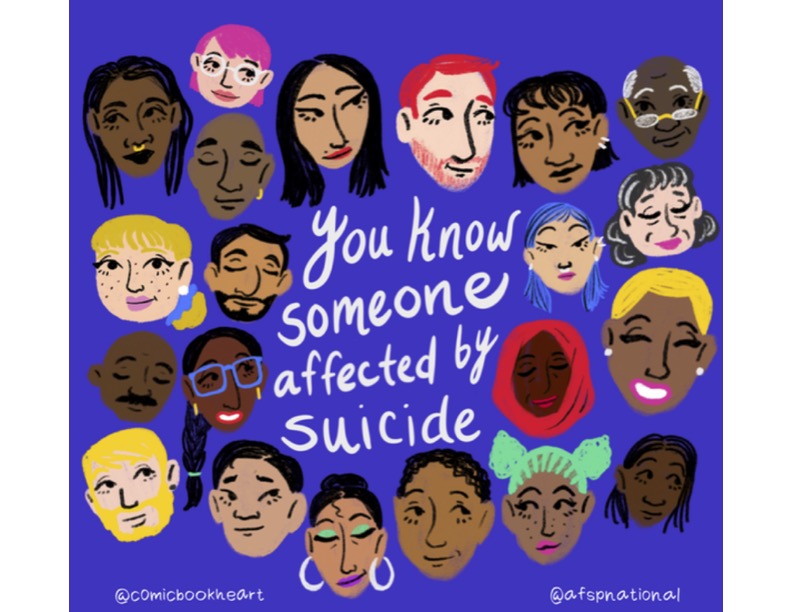Suicide…. Let’s Talk About It.
Marilyn Monroe
Robin Williams
Kate Spade
Anthony Bourdain
Lee Thompson Young
Simone Battle
Chelsie Kryst
Don Cornelius
Phyllis Hyman*
Hyman suffered from bipolar disorder and depression for years, having been diagnosed in the 1980s. She often self-medicated with alcohol and drugs and frequently spoke about suicide. On the afternoon of June 30, 1995, six days before her 46th birthday, Hyman died by suicide by overdosing on a mixture of Tuinal and vodka in the bedroom of her New York City apartment at 211 West 56th Street. She was found unconscious at 2:00 p.m. (EDT) and died at 3:50 p.m. at St. Luke’s-Roosevelt Hospital (now Mount Sinai West) hours before she was scheduled to perform at the Apollo Theater. Her suicide note read in part: I’m tired. I’m tired. Those of you that I love know who you are. May God bless you.
The names listed are just a few celebrities who have died by suicide in recent years.
Suicide is death caused by injuring oneself with the intent to die. A suicide attempt is when someone harms themselves with any intent to end their life, but they do not die because of their actions.
Suicide is the tenth leading cause of death in the United States and second for teens and young adults.
It is the 12th leading cause of death in New York state, where approximately 1700 people die by suicide each year. That’s six times more than the number of New Yorkers who die annually by alcohol-related motor vehicle accidents. [1]
Everyone can play a role in suicide prevention. Concerned individuals in any capacity are in a position to help. Suicide is preventable.
Many factors can increase the risk of suicide or protect against it. Suicide is connected to other forms of injury and violence. For example, people who have experienced violence, including child abuse, bullying, or sexual violence have a higher suicide risk. Being part of a marginalized community or several intersectional identities can increase the risk factor for suicide as well. Mitigating or protective factors include being connected to family/community support and having easy access to healthcare.
Slow Suicide
Slow suicide is a newer term that describes “a prolonged period of self-abusive, harmful behavior, which may result in suicide completion”[2]. So this may look like that one person we all know who takes extreme risks in behavior like excessive drinking and mixing with drugs, talks openly, loosely, and vaguely about death “I don’t care what happens” “If I am here tomorrow okay but if I am not, then so what” or who may verbalize actual suicidal thoughts “I’m going to kill myself” “I wish I hadn’t been born” or “I wish I were dead”. While those seem clear-cut and definitive, it is not always so easy to determine. How many times do we hear “If it were for my kids I would not know what I would do” “I am only holding on because of my mom or _______________(fill in the blank).”
Passive Suicidal Ideation
Experts define passive suicidal ideation as contemplating dying or harboring a wish to die, without actively working toward that outcome [3]. It’s different from being suicidal but if left unchecked could lead to a loss of life.
Passive suicidal ideation is the desire to die without a plan to reach that result. It doesn’t even have to be in words. Daydreaming about your death can be considered passive suicidal ideation. The biggest difference between active and passive suicidal ideation is the desire to act on those thoughts or make plans to bring them to fruition. Many more people that we know are living life every day in a state of passive suicidal ideation. Like Ms. Phyllis Hyman, they might just be “tired” … not tired of living but tired of the pain, of the suffering, and of suffering alone (or feeling like one is suffering alone). So, what can you do? What can we all do? The 3 Rs[4] is one way to help.
3 Rs of Suicide Prevention
Recognize.
Be aware of warning signs that someone might be considering suicide.
Respond.
Engage with that person in distress by speaking up and listening.
Refer.
Connect that person with professional help.
Applying the 3 Rs can assist in overcoming stigma and other obstacles to asking for help and approaching others to help them.
What to look for…applying the 3 Rs
It is important to become aware of some common warning signs and look for ways to support them. Support will often mean being a nonjudgmental listener and seeking professional help. Leaning in and not avoiding…. checking in deliberately and in meaningful ways….asking direct and sometimes uncomfortable questions and listening for answers that are clues…..observing and watching behaviors that are out of character or concerning. Most importantly let the person know you are concerned and willing to help. Offer kindness and attention and let them know you are willing to help them find the support they need.
The following is not an exhaustive list but a good start to explore typical warning signs and red flags:
- Feeling trapped or hopeless
- Exhibiting dramatic mood changes
- Withdrawing from loved ones and society
- Threatening to kill themselves
- Seeking access to the means to kill themselves.
- Talking/writing about death or suicide
- Increasing use of alcohol or drugs
- Behaving recklessly
- Seeking revenge or feeling rage
- Experiencing anxiety or agitation
- Sleep constantly or not being able to sleep
Myths Debunked about Suicide
There is help and there is hope on the other side. Survivors of suicide attempts are working diligently to dispel the myths and fears. Reducing stigma is a huge task, but hopeful efforts show progress. Asking someone who is thinking about suicide will give them permission to open up and share their thoughts and feelings and can lead to connecting that person with help. If they are not suicidal, they will say so and will likely be appreciative that someone expressed care about them.
Myth: People who say they are suicidal are only seeking attention.
Not true.
People who talk about suicide in any way are at higher risk for acting on their suicidal thoughts. All communications about suicide need to be taken very seriously.
Myth: If someone has decided to take their life, no one can stop them.
Not true.
People who think about suicide are sure they want to end their pain. But most have mixed feelings about wanting to end their lives. And 90 percent of those who make a non-lethal suicide attempt do not go on to die by suicide.
Myth: If you are not an expert, you will only make things worse.
Not true.
Individuals in everyday life are in an important position to notice, ask, and encourage people at risk for suicide to get connected with experts.
Another obstacle is that talking about suicide can seem uncomfortable or scary, but once you know how, it’s not as difficult as you might think. And it is really important to start the conversation. If you find yourself worried about someone, the best way to find out is to ask. You can’t make a person suicidal by showing you care. Think about it in terms of giving this person the opportunity to finally express something deep for once. It can begin to provide the relief from the loneliness and pent-up negative feelings…..it may actually prevent a suicide attempt. And most definitely it can open up the path toward a different approach to dealing with the pain, the hurt and the suffering.
You may want to start the conversation as follows:
“I have been feeling concerned about you lately.”
“Recently I have noticed some differences in you and wondered how you are doing?”
“When did you begin feeling like this?”
“Has anything happened to make you start feeling this way?”
“How can I best support you right now?”
“Have you thought about getting help?”
“You are not alone. I am here for you.”
“I may not understand exactly how you are feeling, but I care about you and want to help.”
Continuing the conversation about mental health, emotional wellness and reducing the stigma of suicide can create the environment of psychological safety we all need. Seeking therapy is a great way to ensure we are all getting the help we need to be open about our struggles. The time is now to create spaces for our community to be vulnerable about our emotions, issues and speaking out about our hurt….collectively and individually. We must remember that we are part of the medicine. We are part of the healing.
I want to leave this post with the words of Bell Hooks as encouragement and a call to action for all of us to come together…. run toward each other, not away from one another.
“Rarely, if ever, are any of us healed in isolation. Healing is an act of communion”
Bell Hooks, All About Love (1999)
Resources
If you are concerned for a person’s immediate safety, call 911.
Connect with a trained crisis counselor via the following hotlines and resources available free, confidential, and available 24/7/365.
- 988 National Suicide and Crisis Lifeline. Call or text 988 or chat at 988lifeline.org. To access 988 via chat, visit 988lifeline.org/chat.
- National Suicide Prevention Lifeline at 1-800-273-TALK (8255) ***goes to 988
- The Trevor Project offers suicide prevention services for LGBTQ youth at 1-866-488-7386
- Copline 1-800-267-5463 www.copline.org
Set up for police officers, staffed by retired police officers who volunteer their time, this hotline provides crisis intervention 24/7.
- SAMHSA’s National Helpline offers referrals for substance abuse and mental health treatment at 1-800-662-4357.
- Samaritans Helpline 1-877-870-4673 (HOPE) Call or text
- BlackLine® 1-800-604-5841 Call or text
BlackLine® operates a hotline that people can call or text for support with crisis counseling, to report negative interactions with the police, and to be a referral source for Black, Brown, Indigenous, and People of Color (BIPOC). BlackLine® works to decrease the stigma around mental health in communities of color.
[1] National Institute of Mental Health. Suicide.
https://www.nimh.nih.gov/health/statistics/suicide. Updated June 2022. Accessed September 30, 2022.
[2] Douglas, P. N., LMFT (2019, September 9). The Suicide Method Never Discussed in the Black Community Regarding Men. Medium.
[3] Barnes, M. (2022, October 11). Passive Suicidal Ideation: What It Is and What You Can Do. Psycom. https://www.psycom.net/depression/passive-suicidal-ideation
[4] Suicide Prevention is Everyone’s Business: A Basic Training for New Yorkers (2022-2023) New York State Office of Mental Health







